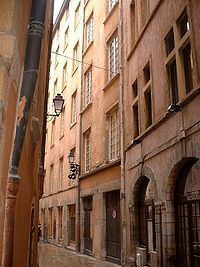Area 30 ha | ||
 | ||
Similar | ||
The Vieux Lyon (English: Old Lyon) is the largest Renaissance district of Lyon in the 5th arrondissement of Lyon.
Contents
This zone is served by the metro line D
In 1954, Vieux-Lyon, the city's oldest district, became the first site in France to be protected under the Malraux law to protect France's cultural sites. Covering an area of 424 hectares at the foot of the Fourvière hill, it is one of Europe’s most extensive Renaissance neighborhoods. There are three distinct sections: Saint Jean, Saint Paul and Saint Georges.
The Saint Jean quarter: in the Middle Ages, this was the focus of political and religious power. The Cathedral of St Jean, seat of the Primate of Gaul, a title still conferred upon the archbishop of Lyon, is a good example of Gothic architecture. The Manecanterie adjoining the cathedral is one of Lyon's few extant Romanesque buildings. Formerly a choir school, it now houses the museum of the cathedral’s treasures. Saint Jean is also home to the Museum of Miniatures and Film Sets, located in a building that was the Golden Cross Inn in the 15th century.
The Saint-Paul section: in the 15th and 16th centuries predominately Italian banker-merchants moved into sumptuous urban residences here called hôtels particuliers. The Hôtel Bullioud and the Hôtel de Gadagne are two magnificent examples and the latter now houses the Lyon Historical Museum and the International Puppet Museum. The Loge du Change stands as testimony to the period when trade fairs made the city wealthy. The Saint Paul church with its Romanesque lantern tower and its spectacular spire mark the section’s northern extremity.
The Saint Georges section: silk weavers settled here beginning in the 16th century before moving to the Croix Rousse hill in the 19th century. In 1844, the architect Pierre Bossan rebuilt the St George's Church on the banks of the Saônein a neo-Gothic style. In the Middle Ages, when there were only a few parallel streets between the hill and the Saône, the first traboules were built. Derived from the Latin trans-ambulare, meaning to pass through, traboules are corridors through buildings and their courtyards, connecting one street directly with another. Visitors can discover an architectural heritage of galleries and spiral staircases in these secret passageways, as unexpected as they are unique.
Saint-Paul au nord
Saint-Paul is the quarter surrounding gare Saint-Paul eand the homonymous church. It's the cultural center of Vieux Lyon, with two main institutes , the Maristes and the Lazarists. The Pont de la Feuillée links these institutes with quai Saint-Vincent and the Terreaux. This area underwent an importante mutation in the end of 19th century with the construction the Saint-Paul station. Many ancients buildings were levelled to make room for the future rue Octavio-Mey and then the Palais du Bondy and the Collège Hôtel.
This district was the scenario of Bertrand Tavernier's movie, The Clockmaker, whose store faced on rue de la Loge, right next to rue Juiverie, which takes its name from the zone where Lyonnais Jews settled during the Middle Ages.
Sites remarquables Place Saint-Paul: The metro station serving the valley of Azergues at north of Lyon was built in 1873 .
L'église Saint-Paul a subi les aléas du temps : construite une première fois en 549, elle fut dévastée par les Sarrasins[réf. nécessaire] et reconstruite au xiie siècle. Furent ajoutés en 1875-77 une flèche et le portail néo-gothique. Elle possède un lanterneau roman réparti en deux dômes octogonaux au sommet de l'édifice. On peut observer l'édifice en bénéficiant d'une vue d'ensemble de la place Gerson, du nom d'un théologien inhumé dans l'église en 1428. Sur la place se trouve la maison Mourguet où le créateur de Guignol y monta des spectacles. Elle possède une tourelle carrée en encorbellement.
Saint-Paul au nord
Saint-Paul is the quarter surrounding gare Saint-Paul eand the homonymous church. It's the scholastic pole of Vieux Lyon, with two main institutes , les Maristes et les Lazaristes. Le pont de la Feuillée le fait communiquer avec le quai Saint-Vincent et les Terreaux. Ce quartier subit une importante mutation à la fin du xixe siècle avec la construction de la gare Saint-Paul. De nombreux immeubles anciens furent détruits avec le percement de la rue Octavio-Mey puis la construction du palais Bondy et du Collège Hôtel.
Ce quartier fut mis en scène dans le film de Bertrand Tavernier L'Horloger de Saint-Paul, dont le magasin se situait rue de la Loge, tout juste à côté de la rue Juiverie, qui tient son nom du fait que les Lyonnais d'obédience judaïque occupaient ce quartier au Moyen Âge.
Sites remarquables La place Saint-Paul : On y construit en 1873 la gare qui desservit la vallée d'Azergues au nord de Lyon.
L'église Saint-Paul a subi les aléas du temps : construite une première fois en 549, elle fut dévastée par les Sarrasins[réf. nécessaire] et reconstruite au xiie siècle. Furent ajoutés en 1875-77 une flèche et le portail néo-gothique. Elle possède un lanterneau roman réparti en deux dômes octogonaux au sommet de l'édifice. On peut observer l'édifice en bénéficiant d'une vue d'ensemble de la place Gerson, du nom d'un théologien inhumé dans l'église en 1428. Sur la place se trouve la maison Mourguet où le créateur de Guignol y monta des spectacles. Elle possède une tourelle carrée en encorbellement.
